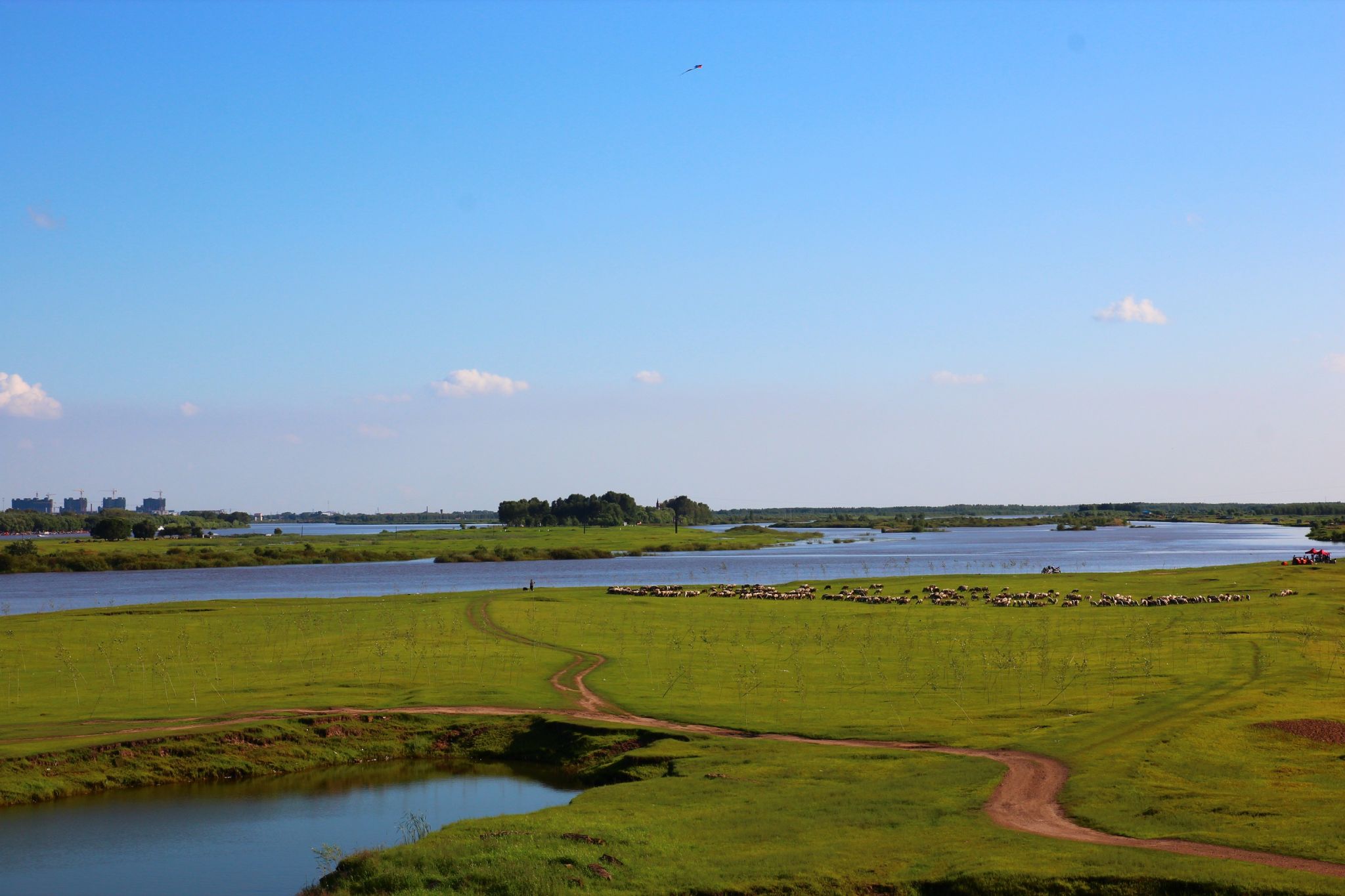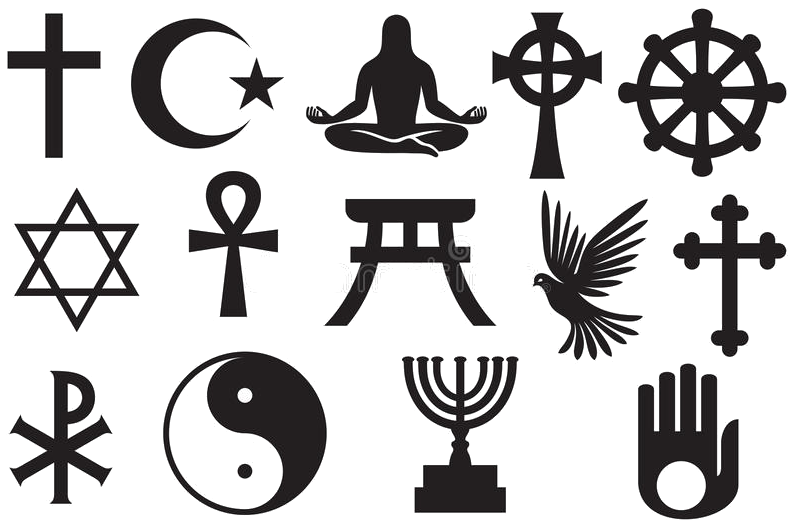
漢德百科全書 | 汉德百科全书
 Heilongjiang Sheng-HL
Heilongjiang Sheng-HL










Schamanismus bezeichnet:
- Im engen Sinne die traditionellen ethnischen Religionen des Kulturareales Sibirien (Nenzen, Jakuten, Altaier, Burjaten, Ewenken, auch europäische Samen u. a.), bei denen das Vorhandensein von Schamanen von europäischen Forschern der Expansionszeit als wesentliches gemeinsames Kennzeichen erachtet wurde.[1] Zur besseren Abgrenzung werden diese Religionen häufig „klassischer Schamanismus“ oder auch „sibirischer Animismus“ genannt.[2]
- Im weiten Sinne alle wissenschaftlichen Konzepte, die aufgrund von ähnlichen Praktiken spiritueller Spezialisten in verschiedenen traditionellen Gesellschaften die kulturübergreifende Existenz des Schamanismus postulieren. Nach László Vajda[3] und Jane Monnig Atkinson[A 1] sollte aufgrund der Vielzahl unterschiedlicher Konzepte treffender von Schamanismen im Plural gesprochen werden.
Sibirische Schamanen und verschiedene Geisterbeschwörer anderer Ethnien – die ebenfalls häufig verallgemeinernd als Schamanen bezeichnet werden – hatten oder haben in vielen traditionellen Weltanschauungen angeblich Einfluss auf die Mächte des Jenseits. Sie setzten ihre Fähigkeiten vorwiegend zum Wohle der Gemeinschaft ein, um in unlösbar erscheinenden Krisensituationen die „kosmische Harmonie“ zwischen Diesseits und Jenseits wiederherzustellen. In diesem weiten Sinne bezeichnet Schamanismus eine Reihe unscharf bestimmter Phänomene „zwischen Religion und Heilritual“.[4][5][6][7][8][9][Anmerkung 1]
Eine nähere allgemeingültige Bestimmung ist nicht möglich, da die Definition verschiedene Betrachtungsweisen aus Sicht der Ethnologie, Kulturanthropologie, Religionswissenschaften, Archäologie, Soziologie und Psychologie enthält.[10][11] Dies hat unter anderem zur Folge, dass Angaben zur räumlichen und zeitlichen Verbreitung der „Schamanismen“ erheblich voneinander abweichen und in vielen Fällen umstritten sind.[12][13][14] Der amerikanische Ethnologe Clifford Geertz sprach daher bereits in den 1960er Jahren dem „westlich idealistischen Konstrukt Schamanismus“ jeglichen Erklärungswert ab.[A 2]
Einig ist man sich lediglich bei der „engen Definition“ des klassisch sibirischen Schamanismus – dem Ausgangspunkt der ersten „Schamanismen“. Dazu gehört vor allem die genaue Beschreibung der dort praktizierten rituellen Ekstase, eine weitgehend übereinstimmende ethnische Religion sowie eine ähnliche Kosmologie und Lebensweise.[15][11][16]
Nach weiter gefassten Definitionen wird Schamanismus bis in die 1980er Jahre als frühe, kulturübergreifende Entwicklungsstufe jeglicher Religion betrachtet.[15] Vor allem das Konzept des Core-Schamanismus von Michael Harner ist hier zu nennen. Diese Auslegung gilt jedoch mittlerweile als nicht konsensfähig.[14] Seit den 1990er Jahren steht häufig der Aspekt des „Heilens“ im Mittelpunkt des Interesses (und der jeweiligen Definition).[10]
Da bereits der klassische Schamanismus Sibiriens etliche Varianten aufweist, werden weiter reichende geographische oder historische Auslegungen, die solche Phänomene aus ihrem kulturellen Kontext gelöst betrachten und verallgemeinern, von vielen Autoren als spekulativ kritisiert.[17][13] In der zeitgenössischen Literatur – populärwissenschaftlichen (insbesondere esoterischen) Büchern, aber auch wissenschaftlichen Schriften – wird in diesem Zusammenhang oftmals nicht deutlich gemacht, auf welche Ethnien sich Darstellungen zu bestimmten schamanischen Praktiken konkret beziehen, so dass regionale (oft sibirische) Phänomene auch in anderen Kulturen verortet werden, in deren Traditionen sie tatsächlich jedoch fremd sind. Beispiele dafür sind der Weltenbaum und die gesamte schamanische Kosmologie: in Eurasien verankerte mythologische Konzepte, die hier mit ähnlichen Archetypen anderer Weltgegenden gleichgesetzt werden und so das irreführende Bild eines einheitlichen Schamanismus erzeugen.[13]
Insbesondere die äußerst erfolgreichen Bücher von Eliade, Castañeda und Harner haben den „modernen Mythos Schamanismus“ erzeugt, der suggeriert, dass es sich dabei um ein universelles und homolog entstandenes religiös-spirituelles Phänomen handeln würde. Im Hinblick auf das große Interesse in der Bevölkerung[18] weisen einige Autoren darauf hin, dass Schamanismus keine einheitliche Ideologie oder Religion bestimmter Kulturen ist, sondern um ein wissenschaftliches Konstrukt aus eurozentrischer Perspektive handelt, um ähnliche Phänomene rund um die Geisterbeschwörer unterschiedlichster Herkunft zu vergleichen und zu klassifizieren.[14][19][20]
萨满是分布于北美洲和北亚、中亚一类巫觋宗敎,包括满族萨满、蒙古族萨满、中亚萨满、西伯利亚萨满、北美洲萨满。萨满(珊蛮)曾被认为有控制天气、预言、解梦、占星以及旅行到天堂或者地狱的能力。萨满目前最盛行于美国,美音美洲的原住民(尤其是北美洲)非常相信,即使是被基督教的美国征服以后。在亚洲的传统始于史前时代并且遍布世界。最崇拜萨满的地方是伏尔加河流域、芬兰人种居住的地区、东西伯利亚与西西伯利亚。满洲人的祖先女真人,也曾信奉萨满,直到公元11世纪。[1]清代以前一直在中国东北甚至蒙古地区大范围流传,清朝皇帝把萨满和满族的传统结合起来,运用萨满把东北的人民纳入帝国的轨道,同时萨满在清朝的宫廷生活中也找到了位置。目前,满族、鄂温克族等民族有很多信奉萨满的人群,并且有萨满。
シャーマニズムあるいはシャマニズム(英: Shamanism)とは、シャーマン(巫師・祈祷師)の能力により成立している宗教や宗教現象の総称であり[1]、宗教学、民俗学、人類学(宗教人類学、文化人類学)等々で用いられている用語・概念である[1]。巫術(ふじゅつ)などと表記されることもある[1]。
シャーマニズムとはシャーマンを中心とする宗教形態で、精霊や冥界の存在が信じられている。シャーマニズムの考えでは、霊の世界は物質界よりも上位にあり、物質界に影響を与えているとされる[2]。
シャーマンとはトランス状態に入って超自然的存在(霊、神霊、精霊、死霊など)と交信する現象を起こすとされる職能・人物のことである[1]。 「シャーマン」という用語・概念は、ツングース語で呪術師の一種を指す「šaman, シャマン」に由来し[1][注釈 1]、19世紀以降に民俗学者や旅行家、探検家たちによって、極北や北アジアの呪術あるいは宗教的職能者一般を呼ぶために用いられるようになり、その後に宗教学、民俗学、人類学などの学問領域でも類似現象を指すための用語(学術用語)として用いられるようになったものである[1]。
Shamanism is a practice that involves a practitioner reaching altered states of consciousness in order to perceive and interact with what they believe to be a spirit world and channel these transcendental energies into this world.[1]
A shaman (/ˈʃɑːmən/ SHAH-men, /ˈʃæmən/ or /ˈʃeɪmən/)[2] is someone who is regarded as having access to, and influence in, the world of benevolent and malevolent spirits, who typically enters into a trance state during a ritual, and practices divination and healing.[2] The word "shaman" probably originates from the Tungusic Evenki language of North Asia. According to ethnolinguist Juha Janhunen, "the word is attested in all of the Tungusic idioms" such as Negidal, Lamut, Udehe/Orochi, Nanai, Ilcha, Orok, Manchu and Ulcha, and "nothing seems to contradict the assumption that the meaning 'shaman' also derives from Proto-Tungusic" and may have roots that extend back in time at least two millennia.[3] The term was introduced to the west after Russian forces conquered the shamanistic Khanate of Kazan in 1552.
The term "shamanism" was first applied by Western anthropologists as outside observers of the ancient religion of the Turks and Mongols, as well as those of the neighbouring Tungusic and Samoyedic-speaking peoples. Upon observing more religious traditions across the world, some Western anthropologists began to also use the term in a very broad sense. The term was used to describe unrelated magico-religious practices found within the ethnic religions of other parts of Asia, Africa, Australasia and even completely unrelated parts of the Americas, as they believed these practices to be similar to one another.[4]
Mircea Eliade writes, "A first definition of this complex phenomenon, and perhaps the least hazardous, will be: shamanism = 'technique of religious ecstasy'."[5] Shamanism encompasses the premise that shamans are intermediaries or messengers between the human world and the spirit worlds. Shamans are said to treat ailments/illness by mending the soul. Alleviating traumas affecting the soul/spirit restores the physical body of the individual to balance and wholeness. The shaman also enters supernatural realms or dimensions to obtain solutions to problems afflicting the community. Shamans may visit other worlds/dimensions to bring guidance to misguided souls and to ameliorate illnesses of the human soul caused by foreign elements. The shaman operates primarily within the spiritual world, which in turn affects the human world. The restoration of balance results in the elimination of the ailment.[5]
Beliefs and practices that have been categorised this way as "shamanic" have attracted the interest of scholars from a wide variety of disciplines, including anthropologists, archaeologists, historians, religious studies scholars, philosophers and psychologists. Hundreds of books and academic papers on the subject have been produced, with a peer-reviewed academic journal being devoted to the study of shamanism. In the 20th century, many Westerners involved in the counter-cultural movement have created modern magico-religious practices influenced by their ideas of indigenous religions from across the world, creating what has been termed neoshamanism or the neoshamanic movement.[6] It has affected the development of many neopagan practices, as well as faced a backlash and accusations of cultural appropriation,[7] exploitation and misrepresentation when outside observers have tried to represent cultures they do not belong to.[8][9]
Le chamanisme est une pratique centrée sur la médiation entre les êtres humains et les esprits de la nature ou les âmes du gibier, les morts du clan, les âmes des enfants à naître, les âmes des malades à guérir, la communication avec des divinités, etc. C'est le chamane qui incarne cette fonction, dans le cadre d'une interdépendance étroite avec la communauté qui le reconnaît comme tel.
Le chamanisme, au sens strict (chamane vient étymologiquement de la langue toungouse), prend sa source dans les sociétés traditionnelles sibériennes. Partie de la Sibérie, la pensée chamanique a essaimé de la Baltique à l'Extrême-Orient et a sans doute franchi le détroit de Béring avec les premiers Amérindiens. On observe des pratiques analogues chez de nombreux peuples, à commencer par les Mongols, les Turcs et les Magyars1 (avant leur christianisation), qui seraient tous originaires de Sibérie, mais aussi au Népal, en Chine, en Corée, au Japon, chez les Scandinaves, chez les Amérindiens d'Amérique du Nord, en Afrique, en Australie, chez les Amérindiens d'Amérique latine2 et également chez les Celtes (druidisme orthodoxe).
Sciamanesimo (o sciamanismo) indica, nella storia delle religioni, in antropologia culturale e in etnologia, un insieme di credenze, pratiche religiose, tecniche magico-rituali, estatiche ed etnomediche riscontrabili in varie culture e tradizioni[1].
El chamanismo se refiere a una clase de creencias y prácticas tradicionales similares al animismo que aseguran la capacidad de diagnosticar y de curar el sufrimiento del ser humano, y en algunas sociedades, la capacidad de causarlo. Los chamanes creen lograrlo contactando con el mundo de los espíritus y formando una relación especial con ellos. Aseguran tener la capacidad de controlar el tiempo, profetizar, interpretar los sueños, usar la proyección astral y viajar a los mundos superior e inferior. Las tradiciones de chamanismo han existido en todo el mundo desde épocas prehistóricas.
Algunos especialistas en antropología definen al chamán como un intermediario entre el mundo natural y espiritual, que viaja entre los mundos en un estado de trance. Una vez en el mundo de los espíritus, se comunica con ellos para conseguir ayuda en la curación, la caza o el control del tiempo. Michael Ripinsky-Naxon describe a los chamanes como «personas que tienen fuerte ascendencia en su ambiente circundante y en la sociedad de la que forman parte».
Un segundo grupo de antropólogos discuten el término chamanismo, señalando que es una palabra para una institución cultural específica que, al incluir a cualquier sanador de cualquier sociedad tradicional, produce una uniformidad falsa entre estas culturas y crea la idea equívoca de la existencia de una religión anterior a todas los demás. Otros les acusan de ser incapaces de reconocer las concordancias entre las diversas sociedades tradicionales.
El chamanismo se basa en la premisa de que el mundo visible está impregnado por fuerzas y espíritus invisibles de dimensiones paralelas que coexisten simultáneamente con la nuestra, que afectan todas a las manifestaciones de la vida. En contraste con el animismo, en el que todos y cada uno de los miembros de la sociedad implicada lo practica, el chamanismo requiere conocimientos o capacidades especializados. Se podría decir que los chamanes son los expertos empleados por los animistas o las comunidades animistas. Sin embargo, los chamanes no se organizan en asociaciones rituales o espirituales, como hacen los sacerdotes.



 Architecture
Architecture

 Vacation and Travel
Vacation and Travel
 Education and Research
Education and Research
 Geography
Geography
 Religion
Religion